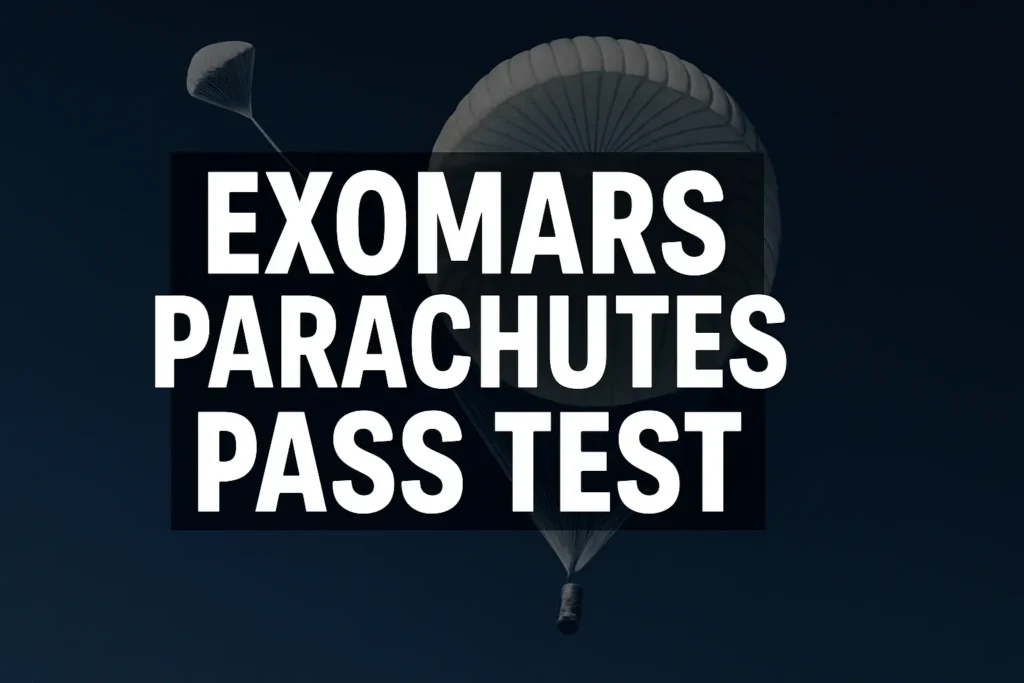The European Space Agency (ESA) has reached a critical milestone in its journey to Mars. After years of development and delays, the ExoMars parachute system—the most advanced and largest of its kind ever designed for planetary exploration—has successfully completed a high-altitude drop test, confirming its readiness for the 2028 launch of the Rosalind Franklin rover.
On 7 July 2025, engineers from ESA and key industry partners executed a successful drop test from 29 km altitude at the Esrange Space Center in Kiruna, Sweden. This pivotal test demonstrated the full functionality of the supersonic and subsonic parachutes under simulated Martian atmospheric conditions, ensuring a safe entry, descent, and landing (EDL) for the upcoming mission.
Engineering a Safe Descent to Mars
Landing safely on Mars remains one of space exploration’s greatest technical challenges. ESA’s ExoMars mission will rely on a dual-parachute system supported by a heat shield and retro-rockets to slow the spacecraft from approximately 21,000 km/h to a gentle touchdown on the Martian surface.
The Parachute System Includes:
- First-Stage Parachute (15 meters): A supersonic parachute, inspired by Viking and Cassini heritage designs, deploys to reduce velocity shortly after atmospheric entry.
- Second-Stage Parachute (35 meters): The largest parachute ever built for Mars, made of more than 800 square meters of fabric and over 4 kilometers of cord, ensures final deceleration at subsonic speeds.
- Retro-Rockets: Fired approximately 20 seconds before landing, these engines provide the final thrust needed for a soft touchdown.
This layered architecture minimizes risk by providing redundant and staged deceleration phases, crucial for a complex mission like Rosalind Franklin, which aims to search for signs of past life on Mars.
Testing Under Martian Conditions
To ensure real-world accuracy, the parachutes were tested using a sounding balloon system that carried a dummy descent module to near-space altitude, where conditions replicate Mars’ thin atmosphere. During a 20-second freefall, the system reached near-supersonic speeds before sequential parachute deployment.
The test verified inflation timing, structural integrity, and descent dynamics using telemetry and high-speed video. This critical data will refine simulations for the upcoming EDL sequence and validate that the parachutes retained full functionality after years in storage.
Overcoming Delays and Storage Challenges
Originally developed for a 2022 launch, the ExoMars mission was postponed due to the geopolitical fallout from the Russia–Ukraine conflict, leading to the suspension of ESA’s collaboration with Roscosmos. Since then, the parachute hardware has been in long-term storage, awaiting retesting and requalification.
ESA’s successful 2025 test not only marks a technical achievement but also validates the durability and readiness of these critical systems after prolonged storage—an essential milestone for mission safety and credibility.
A Collaborative European Success
The ExoMars parachute system is the result of a pan-European effort:
- Italy: Parachute fabric manufacturing
- Netherlands: Deployment mortar systems
- Czechia: Container mechanisms
- UK: Systems analysis and data interpretation
- France (Thales Alenia Space) and UK (Vorticity): System integration and test leadership
This collaborative success underscores Europe’s growing leadership in complex planetary missions and its capability to deliver high-risk, high-reward engineering solutions on a global scale.
Looking Ahead: 2028 Launch, 2030 Arrival
With parachute qualification now secured, the Rosalind Franklin rover mission is scheduled for launch in 2028, targeting the Oxia Planum region of Mars for a 2030 landing. Once on the surface, the rover will deploy a 2-meter drill to collect subsurface samples, analyzing them for biosignatures in one of the planet’s most promising ancient clay-rich regions.
Why This Matters
- Technological First: The 35-meter parachute is the largest planetary parachute ever constructed and successfully tested.
- Mars Landing Safety: Builds on lessons from past failures like the 2016 Schiaparelli crash, improving ESA’s reliability record.
- Strategic European Leadership: Demonstrates ESA’s capability to independently lead interplanetary missions after ending Russian collaboration.
Final Thoughts
The successful requalification of the ExoMars parachute system is a crucial step forward for Europe’s flagship Mars exploration program. As we approach the 2028 launch date, each milestone brings us closer to answering one of humanity’s most profound questions: Was there ever life on Mars?



I’ll be sharing this with my team.
Thanks!